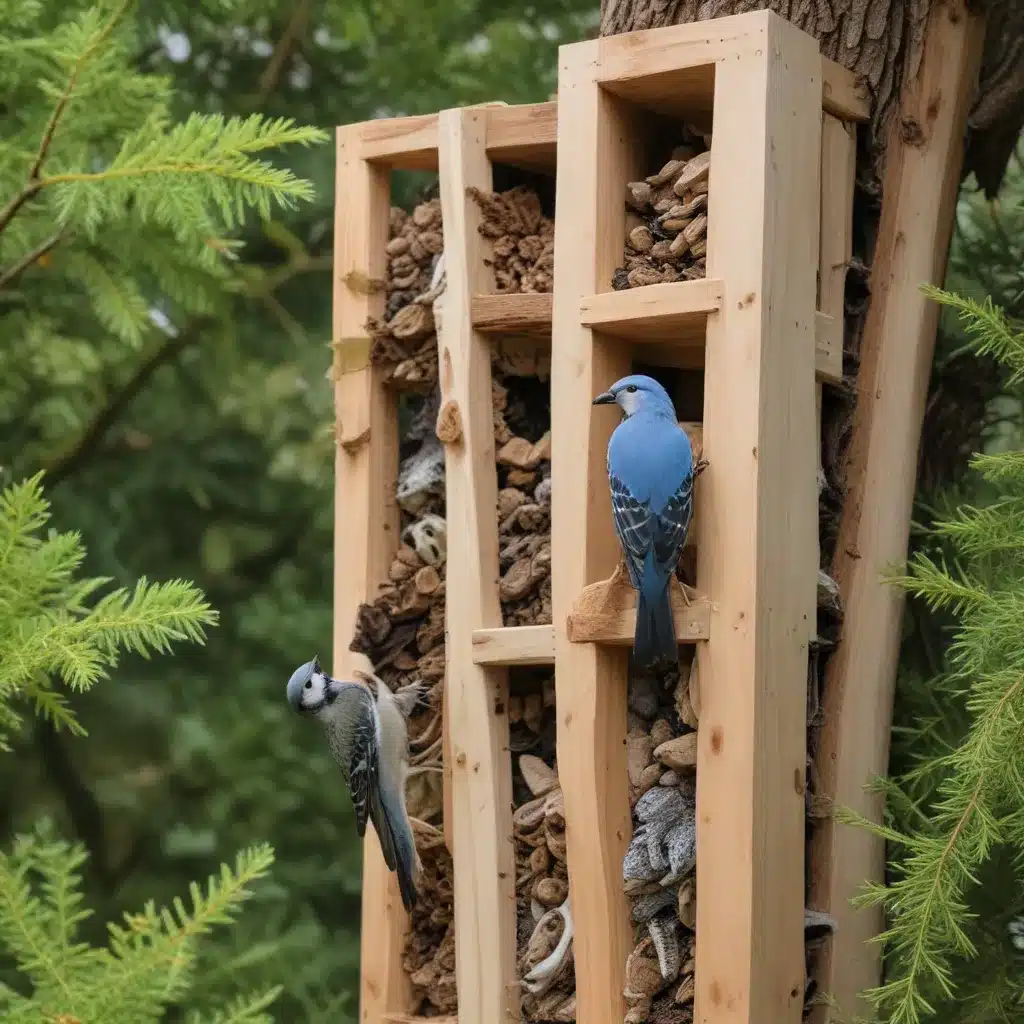
Avian Habitats and Shelter
As an experienced avian caretaker, I know that providing ample vertical space is crucial for the wellbeing and enrichment of our feathered friends. Birds are naturally drawn to elevated perches, nesting sites, and structures that allow them to engage in their instinctive behaviors. By thoughtfully designing and optimizing vertical elements in your avian habitat, you can create an environment that truly caters to your avian companions’ needs.
Bird-Friendly Vertical Structures
When it comes to enhancing vertical space, the options are truly limitless. From towering trees and sturdy wooden posts to repurposed ladders and suspended ropes, the key is to offer a diverse array of structures that birds can explore, roost, and even nest upon. Sturdy branches, angled platforms, and perches of varying diameters will cater to the preferences of different species. Incorporate natural materials like bamboo, driftwood, and grapevine to blend seamlessly with the environment.
Nesting Platforms and Boxes
Providing suitable nesting sites is paramount for the breeding and reproductive success of your avian residents. Strategically place nesting platforms and boxes at various heights, ensuring they are positioned away from high-traffic areas and potential predators. The size, shape, and entrance dimensions should be tailored to the specific needs of the target species. Regularly maintain and clean these structures to prevent the buildup of pests and ensure a safe, sanitary environment for nesting birds.
Maximizing Vertical Space
When designing your avian habitat, think vertically. Utilize wall space, ceiling areas, and even the underside of overhangs to expand the available vertical real estate. Tiered shelving, wall-mounted perches, and hanging baskets can all contribute to a rich, multi-layered environment that caters to the natural behaviors and needs of your birds. Experiment with different configurations and materials to find the optimal setup for your avian residents.
Avian Feeding and Foraging
Providing diverse feeding and foraging opportunities is essential for maintaining the health and vitality of your avian community. Elevating these resources can enhance accessibility, promote natural behaviors, and even deter unwanted ground-dwelling visitors.
Elevated Feeding Stations
Strategically place feeding stations at varying heights to accommodate the preferences and abilities of your avian residents. Sturdy platforms, hanging feeders, and pole-mounted trays can all serve as elevated dining spots. Consider the size, shape, and perching options of each feeding station to cater to the specific needs of your birds.
Vertical Herb and Flower Gardens
Incorporate vertically-oriented herb and flower gardens to enrich the foraging experience for your avian friends. Hanging planters, tiered garden beds, and vertical hydroponic systems can bring a touch of verdant beauty while offering a natural source of nutrition. Choose bird-friendly plants that provide seeds, berries, or nectar to encourage exploration and active foraging.
Hanging Feeders and Seed Towers
Suspend feeding stations, suet cakes, and seed-filled towers at varying heights to create a dynamic and engaging foraging landscape. The swinging motion and elevated placement of these resources can stimulate the natural curiosity and agility of your birds. Experiment with different attachment methods, feeder designs, and seed blends to cater to the preferences of your avian community.
Avian Health and Safety
Ensuring the health and safety of your avian residents is of paramount importance. When designing vertical elements in your habitat, consider the unique needs and vulnerabilities of your birds to create a secure and enriching environment.
Predator-Resistant Vertical Designs
Protect your feathered friends from potential predators by incorporating predator-resistant features into your vertical structures. Smooth, slippery surfaces, enclosed nesting areas, and strategic placement away from ground-level threats can all contribute to a safer environment. Consult with experts and research the specific threats faced by the species in your care.
Ventilation and Shade Considerations
Vertical structures can impact the airflow and temperature within your avian habitat. Ensure adequate ventilation by incorporating strategically placed openings, fans, or even natural airflow pathways. Provide shaded areas, such as canopied perches or sheltered nesting sites, to offer respite from direct sunlight and heat.
Seasonal Adaptations for Vertical Spaces
Adapt your vertical structures to accommodate the changing needs of your birds throughout the seasons. In colder months, consider adding insulation, windbreaks, or supplementary heating to protect against the elements. During warmer periods, incorporate cooling features like misters or evaporative pads to maintain a comfortable environment. Observe your birds’ behaviors and adjust your vertical designs accordingly.
Avian Community and Conservation
By thoughtfully incorporating vertical elements into your avian habitat, you can not only enhance the wellbeing of your resident birds but also contribute to the larger conservation efforts within your community.
Attracting Native Bird Species
Strategically designed vertical structures can serve as a powerful draw for native bird species in your area. Research the nesting, roosting, and foraging preferences of local avian populations, and tailor your vertical elements accordingly. This can help foster a diverse and thriving avian community within your habitat.
Enhancing Biodiversity in Urban Areas
In urban and suburban settings, incorporating vertical structures can play a crucial role in supporting avian biodiversity. Provide nesting sites, perching options, and foraging opportunities that cater to a variety of bird species, from songbirds to raptors. This can help offset the challenges posed by limited natural habitats and promote a healthy, vibrant avian ecosystem.
Sustainable Vertical Gardening for Birds
Embrace the principles of sustainable gardening when designing your vertical elements. Utilize recycled, repurposed, or locally sourced materials, and incorporate native plant species that offer valuable resources for your avian residents. By prioritizing sustainability, you can minimize your environmental impact while creating a truly bird-friendly habitat.
As an experienced avian caretaker, I’ve seen firsthand the transformative power of thoughtfully designed vertical spaces. By prioritizing the unique needs and behaviors of our feathered friends, we can create environments that not only support their wellbeing but also contribute to the broader conservation of avian species. I encourage you to explore the endless possibilities of vertical enhancements and embark on a journey to provide your avian companions with the enriching, secure, and sustainable habitats they deserve.


